

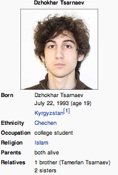 DAYTONA BEACH -- The Boston Bombers, brothers Tamerlan and Djokhar Tsaraev, lived up to their violent Chechen heritage, even though neither was raised in Chechnya.
DAYTONA BEACH -- The Boston Bombers, brothers Tamerlan and Djokhar Tsaraev, lived up to their violent Chechen heritage, even though neither was raised in Chechnya.
Having spent their childhoods in Kyrghistan and the United States, it is not clear if either had ever even been to Chechnya.
Yet they proved themselves as gratuitously violent as any of their kinsmen.
A mountainous region in the south Caucasus of Russia, Chechnya is populated by warring clans called Taibs.
YouTube / The Tsaraev brothers are representative of Muslim extremism from a region of the world that hates Russians and Americans alike.
Chechnya is the product of repeated invasion, repeated retreats into the harsh mountains, violent guerilla resistance and, in modern times a reliance on terrorism and criminal behavior as default reactions to perceived slight.
Ironically, since it appears that the Tsaraevs were motivated by radical Islam, Chechnya came late to the Muslim faith, much of it converting from Eastern orthodox Christianity in the early 19th Century when they were hoping to gain Ottoman or Persian support against the inroads of Czarist Russia.
Ironically, since it appears that the Tsaraevs were motivated by radical Islam, Chechnya came late to the Muslim faith, much of it converting from Eastern orthodox Christianity in the early 19th Century when they were hoping to gain Ottoman or Persian support against the inroads of Czarist Russia.
The Chechen commitment to Islam, along with that of most other Caucasus mountain groups, was cemented by the 20-year resistance led by Islamic fundamentalist Sheikh Shamil the Avar, a ferocious guerilla leader who was only brought to book when Czar Nicholas I committed 250,000 soldiers to the war.
Thereafter, Chechen hostility toward foreigners was focused almost entirely on the Russians.
In World War II, some Chechen leaders flirted with the Nazis and Stalin deported the entire Chechen population to Central Asia, giving their homes and farms to loyal Russians and Ossetians.
Most Chechens returned after Stalin’s death in 1953, but some remained in Central Asia, which explains how the Tsaraevs happened to find themselves in Kyrghistan.
As the Soviet government weakened in the 1980s, the Chechens moved into crime in a big way and became infamous as the most powerful and most violent of the mafia organizations in the USSR.
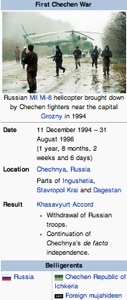
 Brothers Tamerlan and Djokhar Tsaraev are ethnic Chechens, a country within a country that has tried to break away from Russia since the collapse of the Soviet Union, with the first and second Chechen wars as described in these snapshot graphics at left.
Brothers Tamerlan and Djokhar Tsaraev are ethnic Chechens, a country within a country that has tried to break away from Russia since the collapse of the Soviet Union, with the first and second Chechen wars as described in these snapshot graphics at left.
With the collapse of the USSR, follow-on governments moved swiftly to take over the roles of the country’s several mafias, but the Chechens quickly shifted to demands for independence.
Russia resisted and then President Yeltsin first attempted to restore order in Chechnya via a coup using a compliant Chechen leader.
When that failed in 1994, regular Russian troops attacked and destroyed the Chechen capital of Grozny and the first Chechen War had begun.
A mutually unsatisfactory peace was negotiated in 1996, characterized by frequent kidnappings, assassinations and other acts of terrorism perpetrated by both sides.
In 1999, a Chechen raiding party attacked targets in the neighboring Russian province of Daghestan. New Russian President Putin seized upon this as an excuse to reoccupy Chechnya and the second Chechen War got underway.
Putin’s armies were better trained and equipped than those of Yeltsin and Chechnya was overrun by late spring of 2000.
An agreement was reached with a pro-Russian Chechen faction in 2002, and the appearance of government was restored, but violent resistance continued and sometimes included acts of Chechen terrorism.
The Russian army’s brutal tactics won growing sympathy in the West for the Chechens but this was dissipated by three things.
First, in 2002, Chechen terrorists occupied a Moscow theater and seized 129 theatergoers as hostages. When negotiations with Russian authorities broke down the Russians poured poison gas into the theater, killing the 29 terrorists as well as 129 hostages.
Second, in 2004 Chechen terrorists seized a children’s school in the Russian town of Beslan and held several hundred children and teachers hostage. They rigged the school with explosives and promised mass death if the authorities attacked.
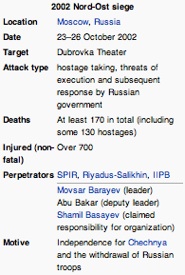
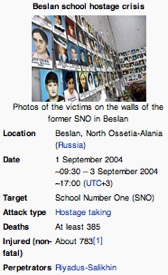
Chechen nationalists embarked on two major terrorist attacks on Russia with mass casualties, the first being the 2002 Russian theater siege, known as the Nord-Ost Siege, and the second two years later, being the Beslan school hostage crisis, shown in these snapshot graphics at left. Click the videos above for a visual recap.
Again, negotiations were unsuccessful and Russian forces stormed the school, killing all of the terrorists as well as some 331 hostages. Third, the collapse of Soviet power coincided with the rise of radical Islam within the Muslim world.
Saudi Wahabis, Taliban representatives and jihadis of all stripes swarmed into Chechnya where they found a receptive audience among a Muslim population uncertain of their faith due to decades of Soviet occupation and steeped in the Sufic mysticism of the Qadiris and the Nakhshibandis.
The result of this process - and this is a hideously oversimplified description of it - is a dramatic shift in Chechen perception away from Russia as their enemy and toward all those, certainly including the United States, who are regarded by the jihadis as hostile to Islam.
This is the national and cultural tradition which would have been impressed upon the Tsarnaev brothers and which contributed to their adoption of terrorism, apparently in the name of Islam. But who moved them from the lives of successful immigrants who seemed to adapt to life in America even if they did not entirely embrace it? Who convinced young men who had come to this country as children of ages 15 and 8 that their best choice was mass destruction and death?
This is the national and cultural tradition which would have been impressed upon the Tsarnaev brothers and which contributed to their adoption of terrorism, apparently in the name of Islam. But who moved them from the lives of successful immigrants who seemed to adapt to life in America even if they did not entirely embrace it? Who convinced young men who had come to this country as children of ages 15 and 8 that their best choice was mass destruction and death?
Much remains to be discovered about them, but there are reports that their mother grew increasingly radicalized and that she passed some of this on to her sons. As devout Muslims, they must have attended a mosque regularly.
But which mosque, who is their Imam there and what is taught in their Friday sermons and their religious instruction classes?
Once radicalized, it is clear that they had some help. Someone taught them how to make proper pipe bombs, pressure cooker bombs and hand grenades. It is possible that it was Tamerlan who received this training during a several-month trip abroad, which included travel to Daghestan, but that remains to be determined.
Certainly, the Russians thought he was involved in something dangerous as their FSB (the successor to the KGB) flagged him to the FBI, but the FBI investigation turned up nothing.
Someone funded them. They seem to have had little or no after action support structure as they made no attempt to flee the Boston area.
Perhaps the Tsaraev brothers were expected to sacrifice themselves as so many other terrorists have.
These and other questions may yet be clarified if Dzhokhar Tsaraev lives long enough to be interrogated.
Fortunately, the U.S. government has so far elected to use the “public safety” exception to the Miranda law, which permits us to deny Miranda rights to someone whose actions may yet threaten public safety even though he/she is in custody.
What is clear is that the Boston Bombings were the most successful domestic act of terror directed against the United States since 9/11. The authorities did a masterful job of identifying and taking down the perpetrators. But to terrorist planners, the fate of the perps is not the important thing.
What is clear is that the Boston Bombings were the most successful domestic act of terror directed against the United States since 9/11. The authorities did a masterful job of identifying and taking down the perpetrators. But to terrorist planners, the fate of the perps is not the important thing.
Think of it.
The bombings, in the heart of one of America’s largest cities, killed four (the MIT officer in the aftermath) and injured about 170.
It seized and held the attention of the country and of much of the world for over a week. It shut down public transportation throughout the region. It forced people into their homes in terror and prevented them from the normal conduct of their lives.
The purpose of terror is to spread terror, and the Boston Bombings certainly accomplished that.
The purpose of terror is to spread terror, and the Boston Bombings certainly accomplished that.
And there is one more thing: Terrorism is also designed to rouse the anger and mistrust of the citizenry against their government. And it is doing that as well.
Think how much more controlled and regulated we all are now than we were before 9/11. Consider the long lines at airports, the increased power of the federal government to eavesdrop, to arrest without warrant, to seize control of the nation’s assets and productive capacities.
Recognize how many of us resent this and how many now fear that our own government can threaten traditional American liberties.
Perhaps it is necessary to cede these new powers to government if it is to protect us from terrorists, especially now that we see that they can be home grown from children.
It may already be too late, but we as a people need to recognize and our leaders need to be aware that our country will have to walk a very fine line if we are to be safe and retain our God-given liberties at the same time. That is what we should learn from the Tsaraev brothers.
It may already be too late, but we as a people need to recognize and our leaders need to be aware that our country will have to walk a very fine line if we are to be safe and retain our God-given liberties at the same time. That is what we should learn from the Tsaraev brothers.
Fast Facts: Stan Escudero
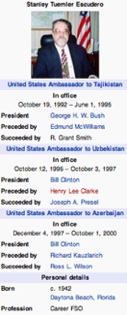 Stan Escudero is a regular contributor to Headline Surfer as the chief political blogger and as a panelist on "The Roundtable," the 24/7 internet newspaper's news and public affairs online show.
Stan Escudero is a regular contributor to Headline Surfer as the chief political blogger and as a panelist on "The Roundtable," the 24/7 internet newspaper's news and public affairs online show.
Headline Surfer is the Award-Winning 24/7 Internet Newspaper Serving Greater Daytona Beach via HeadlineSurfer.com, NSBNews.net and VolusiaNews.net.
